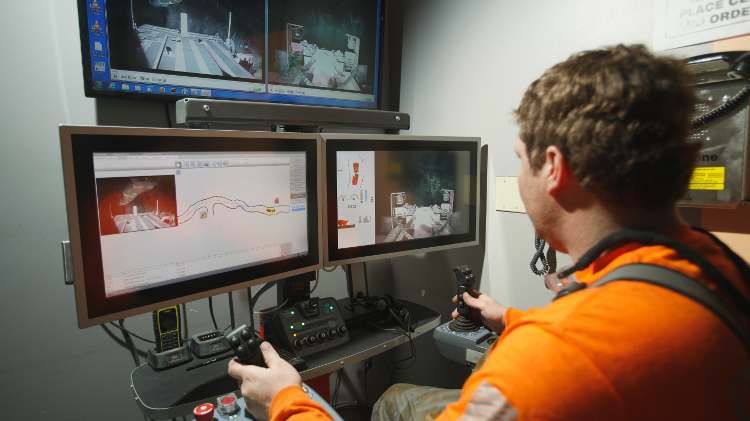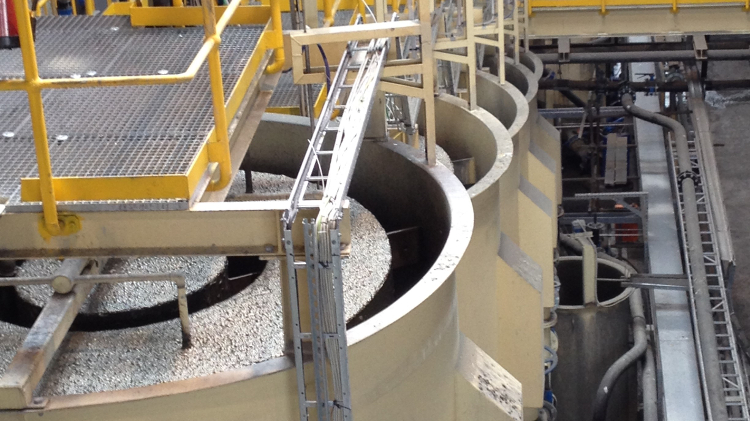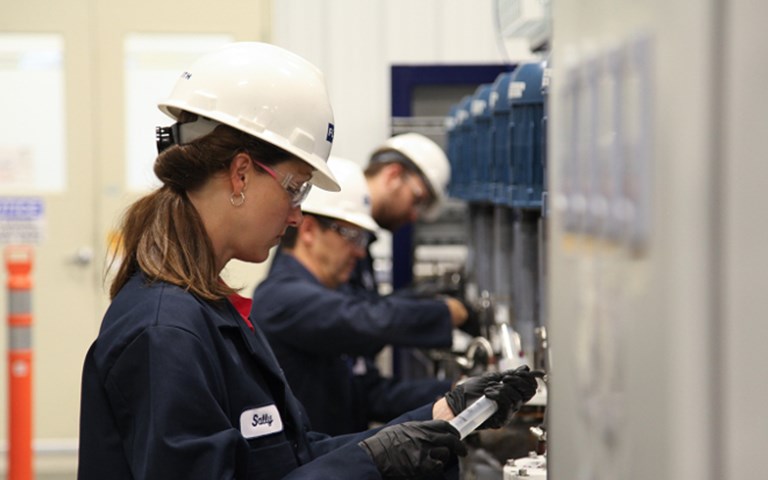Sally Rocks, senior research and development chemist on the FLSmidth ROL process team, worked with chemical engineers, geologists and mineral processing engineers to perfect the technology. Courtesy of FLSmidth
The copper mining industry is reaching a turning point. Surface oxide deposits are depleting and copper miners are turning their attention to untapped sulfide ores found deeper underground. However, sulfides require more expensive processing techniques since they are not responsive to standard technologies that are used in oxide heap leaching.
To make the transition from oxides to sulfides as seamless and economical as possible, it benefits copper miners to invest in copper sulfide extraction processes that integrate and maximize production from existing solvent-extraction and electrowinning (SX/EW) infrastructure, according to Gary Roy, director for FLSmidth’s rapid oxidative leach (ROL) process.
“Oxide ores around the world have been leached out to a certain extent and the copper pregnant leach solution (PLS) grade coming out of the heaps is being reduced. Mines have this big infrastructure with an SX/EW to produce cathode, but they’re struggling to maintain production rates,” said Roy. “They have this big infrastructure sitting there that’s not fully utilised.”
A smelting workaround
The traditional route for extracting copper from sulfide ores is smelting. Yet there is a growing case for leaching sulfides from lower grade ore bodies and especially for those ore bodies containing problematic elements like arsenic, which make smelting less economical.
Smelting is increasingly expensive because, in general, smelters require a content of more than 25 per cent copper. Given the falling content and quality of global copper reserves, this figure is becoming harder to meet, and copper producers must ship more concentrate to smelters to yield the same amount of copper or pay an additional treatment cost to blend their low-quality concentrates with other higher copper-content concentrate. This is in addition to the costs the miners are charged for refining and transporting the concentrate to an off-site, often distant, smelting facility.
On top of this, most smelters will not treat concentrates with high levels of arsenic. Of the few that do, they impose high penalties on miners. An increasing share of the remaining global copper deposits are laced with arsenic and this too provides an imperative for miners to consider alternative technologies.
These were all reasons why a team of FLSmidth engineers spent five years researching leach technologies that economically process copper sulfides. The result, the ROL process, was patented in 2015 and is being vetted by several clients this year at the Danish engineering firm’s Salt Lake City pilot plant.
The main challenge the research team faced was to find a way to economically leach chalcopyrite and enargite, a copper arsenic sulfosalt mineral. Chalcopyrite has historically been a challenge to hydrometallurgical engineers because it resists leaching under atmospheric conditions. One reason for its refractor behaviour is the elemental sulfur layer that forms on the surface of the chalcopyrite particles when they are leached, bringing the copper dissolution process to a halt.
The search for a commercially viable, hydrometallurgical technology to extract copper from chalcopyrite and enargite has so far been fruitless. Attempts dating back to the 1970s have involved energy-intensive ultra-fine grinding, catalysts, high temperatures and high pressures. While many approaches were technically successful, they were too expensive to roll out.
Fresh mineral surfaces
Sally Rocks, senior research and development chemist on the FLSmidth ROL process team, is working closely with a team of chemical engineers, geologists and mineral processing engineers to perfect the technology.
The first step in the discovery process was a comprehensive review of decades of research on copper sulfide leaching. In doing so, the team detected a pattern that suggested that surface abrasion alone could have a significant impact on a mineral’s leaching behaviour.
Their initial test involved simply adding a small amount of ceramic grinding media to a leach reactor containing chalcopyrite concentrate mixed with acid, water and ferric sulfate. “Much to our happiness, it ended up improving the copper leach rate dramatically,” Rocks said.
The vessel was scarred in the process but remains in the lab as a memento to their achievement. “[The experiment] actually wore away some of the glass,” she explained, “but the destruction of that reactor was worth it for what we learned.”
The leach rate improved because a freshly-exposed mineral surface – like the abraded chalcopyrite in the experiment – has all kinds of broken bonds and is therefore more reactive. “People have really underestimated the reactivity of fresh mineral surfaces,” Rocks said.
Surface abrasion is therefore at the heart of the ROL process. The primary leach vessels are linked to a satellite reactor called a stirred media reactor (SMRt), and the leaching materials circulate between the two. Grinding media in the SMRt reactor can also gently scrub the passivating sulfur layer from the chalcopyrite and exposes fresh and highly-reactive surfaces for leaching. The material then goes back into the leach tank to undergo the chemistry. When the particles start building up an offending passivating layer from insoluble reaction products, such as sulfur, gypsum and silicates, they may go back through the SMRt reactor.
The amount of time it takes for the passivating layer to build up depends on the mineralogy. For the majority of chalcopyrite concentrates, an initial SMRt reactor contact is required and a second contact approximately two hours into the leach is often beneficial. Additional transits through the SMRt reactor after the second hour are not necessary.
The entire process leaches 98 per cent of copper from chalcopyrite concentrates in less than six hours and can tackle materials laced with arsenic in as little as nine hours.
Related: The shift in universities from metallurgy programs to materials science and engineering
Compared to ultra-fine grinding mills, SMRt reactors function on less than one tenth the energy, and over the years, the FLSmidth researchers have calculated the exact amount of energy needed to gently scrub off the passivating layer. As a result, the ROL process team anticipates that miners using the technology will lower their energy consumption per mass of copper produced.
Rocks and her team also discovered that doping the chalcopyrite with a small amount of copper sulfate prior to leaching sped up the process dramatically, “supercharging” the leach. This pre-treatment step is a key element of the ROL process.
Implemented on an industrial scale, this “activation” pre-treatment step is flexible and has shown much success with residence times less than 30 minutes and takes place in a tank and/or a mill. “Any acidic leach process will include an acidulation step prior to the leach, and all the pre-treatment requires is some additional chemistry in this acidulation step,” Rocks explained.
The value proposition
Roy, who also serves as ROL process line manager, said the process is best suited to sites “transitioning from heap leach operations to concentrators,” and mines “that can’t get a good grade, or that have a lot of penalty elements, like arsenic.” The ROL technology can be integrated with existing SX/EW and equipment and helps miners maintain copper cathode production on site. Mines can avoid the steep cost of shipping all of their concentrate to smelters by sending only higher purity concentrates.
Moreover, while FLSmidth can install an entirely new leach plant – agitators, pumps, motors, tanks and all – they are also able to retrofit existing leach infrastructure by adding SMRt reactors.
Roy added that the “flexible” technology caters to the “fluctuating” nature of copper production. It gives mines the opportunity to divert their minerals to the ROL on “bad days,” so they do not have to dilute good concentrate headed to the smelters.
Unlike some leach processes, the technology can also be scaled down economically to accommodate smaller operations.
While Roy could not give specific figures on how much value can be saved, he said he believes the technology has the potential to help miners save on capital expenditure, given that the ROL process makes use of existing SX/EW assets and does not require any extra pressure leach vessels; it functions at atmospheric temperatures and 80 to 90 C. They can also save on operating expenses as the technology does not require upfront ultra-fine grinding or any catalyst recovery, regeneration or recycling unit operations.
Moreover, as high-grade resources deplete and miners turn increasingly to arsenic-laden ore bodies, the technology’s capacity to process the problematic element is another of its key selling points. In Chile, where more than 20 per cent of global copper deposits are based, half of the mines are now contending with arsenic. “Arsenic levels in concentrates have been increasing dramatically, and it’s not going to get better,” said Roy.
The ROL process will also mitigate the accidental release of the poisonous element into the environment, given that arsenic-laden concentrate will no longer have to be transported over long distances to smelters.




